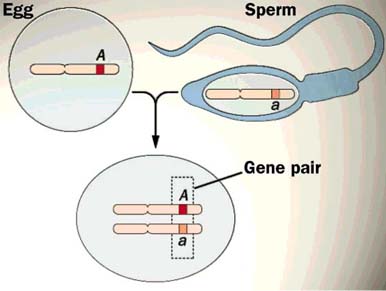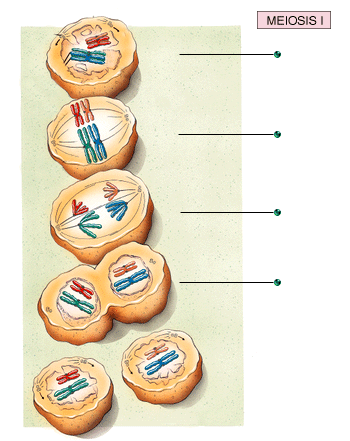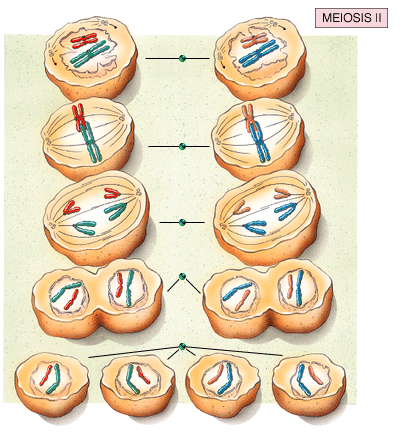Meiosis
Click on one of the following links to jump to a specific subtopic on this page, or scroll the text up and down to find what you need.Diploid/Haploid
Meiosis I
Meiosis II
We said that meiosis is the two step division process by which sperm and eggs are produced. But there are several concepts that need to be addressed before we look at that process.

We also said that humans have 46 chromosomes in each somatic cell. However, since humans have two of every type of chromosome (not counting gender differences), that means that we really have two sets of 23 chromosomes. One set came from your mother and one set came from your father. Notice here that each parent is contributing only 23 chromosomes, which is one half of the total in somatic cells. Therefore, meiosis has to produce specialized reproductive cells called gametes in general, sperm and eggs specifically, which have one of every type of chromosome. After fertilization, then the number of chromosomes in the developing zygote is returned to 46.

Organisms or cells with two of every type of chromosomes are called diploids. Organisms or cells with one of every type of chromosomes are called haploids. Human somatic cells are diploid while the gametes are haploid. Meiosis then is a process by which haploid cells are produced.
There is an additional concept which uses the letter N to represent the haploid number of chromosomes. Therefore, gametes are 1N while somatic cells are 2N.
Also, the letter C is used to represent a haploid amount of DNA in a cell. Remember that unreplicated chromosomes have only one piece of DNA each while replicated chromosomes have two pieces of DNA each (refer to previous key word list). Therefore, a 1N cell can be 1C or 2C and a 2N cell can be 2C or 4C depending on the replication state of their chromosomes.

A cell ready to undergo meiosis (2N, 2C), enters in to one last Interphase where its chromosomes are replicated (2N, 4C). If this were mitosis, it would remain in this state until Anaphase when the chromatids separate forming two daughter cells (2N, 2C each). However, in the first meiotic division (called meiosis I), during Prophase while the chromosomes are condensing, each type of chromosome pairs up lengthwise with the other chromosome of that type ultimately forming 23 pairs of chromosomes. This pairing process is called synapsis. Chromosomes of the same type are called homologous chromosomes and each member of a pair is referred to as a homolog or homologue. At Anaphase of meiosis I, rather than chromatids separating, the homologs separate with one of each pair going to a different daughter cell (1N, 2C). In this way, the chromosome number is reduced in half during meiosis I and two haploid cells are produced. Because of this, meiosis I is called the Reductional Division.

After meiosis I, there is no additional Interphase. Sometimes the cells produced in meiosis I will go in to a prolonged resting state which is referred to as interkinesis. In meiosis II, each of the two daughter cells produced in meiosis I will divide essentially as occurs in mitosis. It is in meiosis II that the chromatids separate forming a total of four daughter cells (1N, 1C) for every cell entering in to meiosis. Meiosis II is called the Equational Division.

In males, four sperm are produced for each cell undergoing meiosis. But in females, certain special events occur through which only one mature egg will be produced per starting cell. Meiosis I takes place as above. However, of the two potential cells to be produced, one of them keeps the bulk of the cytoplasm to itself leaving the other nucleus without cytoplasm. This nucleus which is called a primary polar body will degenerate and the chromosomes it contains will be lost. The same thing happens in meiosis II forming what is called a secondary polar body which is also lost. So, for each cell starting meiosis in females, only one mature egg is produced carrying most of the cytoplasm of the original cell. This is necessary since it is the egg which provides the cytoplasm from which the fetus will develop. There is not enough in the starting cell to produce four eggs.